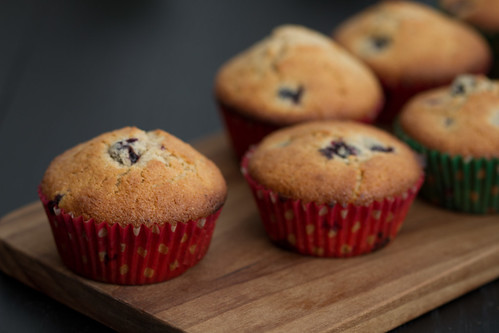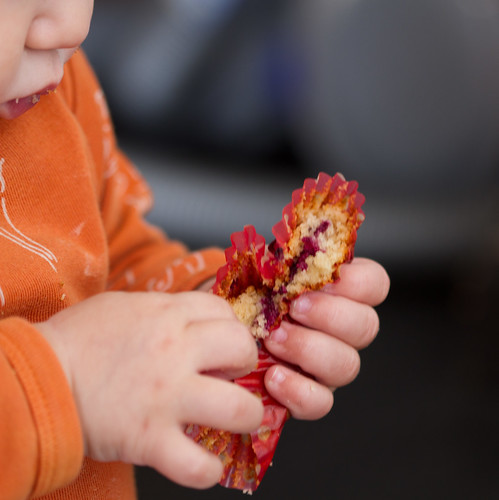
Photo updated in September 2013
When you look at the picture below, then these muffins look a lot like blueberry/bilberry/bog bilberry muffins, don't they? But nope, the berries that lend those dark speckles are not of the Vaccinium genus at all, but Black Chokeberries (Aronia melanocarpa), belonging to the Rosaceae family. It's a popular hedge plant here in Estonia, and because my aunt Vaike has a whole garden hedged off with chokeberry shrubs, a whole basket of ripe black chokeberries landed on my doorstep recently.

Our little daughter (10 months old already!) with her black aronia muffin in September 2013
Chokeberries? Never heard of them? What about Aronie à fruits noirs/Aronie noire in French, Schwarze Apfelbeere/Schwarze Eberesche in German, marja-aronia in Finnish, svart aronia in Swedish?? Well, chokeberries, which look a bit like rowanberries (only purplish-black), are considered functional food or nutraceuticals because of its high anthocyanin content. Those very anthocyanins contribute towards the astringency of the black chokeberries, but also gives them 'extraordinary antioxidant strength'. According to Wikipedia,
'a test tube measurement of antioxidant strength, the Oxygen Radical Absorbance Capacity or ORAC, has demonstrated chokeberry with one of the highest values yet recorded, of 16,100 micromoles of Trolox Eq. per 100 g- [Also the] total anthocyanin content in chokeberries is 1480 mg per 100 g of fresh berries, and proanthocyanidin concentration is 664 mg per 100 g. (Wu et al. 2004)'
(Whatever that means, it sounds impressive. All you need to know is that black chokeberries are incredibly good for you:)
Apart from all those impressive-sounding characteristics, black chokeberries have their place in the kitchen as well. They can be used to make jam (on their own or mixed with apples), astringent juice, and wine. As long as I can remember, my mum & auntie Vaike have made black chokeberry cordial (arooniasiirup) that we dilute with water during the year to make a refreshing drink. And I'll be making this cordial from some of the berries soon. But as I haven't baked for a few days, I decided to make black chokeberry muffins, using a Finnish Marttajärjesto recipe I had bookmarked ages ago. Yes, the dark berries in the muffins are a bit astringent, but they were juicy and delicious, just like superberries are supposed to be :)
Chokeberry Muffins
(Arooniamuffinid)
Makes 12 'European' sized ones

125 grams butter, at room temperature
100 grams caster sugar
2 large eggs
2 tsp vanilla sugar
2 tsp baking powder
350 ml plain/all purpose flour (ca 210 g)
100 ml milk (100 g)
100 grams cleaned black chokeberries
Cream butter with sugar, add eggs one by one, mixing thoroughly after each addition.
Mix flour, vanilla sugar and baking powder, then add to the egg mixture together with the milk, stirring just as much as needed to combine the ingredients.
Fold in the chokeberries.
Divide into 12 prepared muffin cases and bake at 200 C for 15-20 minutes.

24 comments:
yeah, just add yet ANOTHER berry to your eternal discussion ;-) these muffins look delectable, I wish I could try some. healthy or not.
always fun to discover a new berry! I had never heard about these ones before! Delicious muffins!
Pille, we can never have enough muffins in the world. Thanks for your great entry for Weekend Herb Blogging!
Pille, I love bluberries, blackberries, strawberries, etc. so in muffins are delicious, I will try this recipe. Thanks.Have a nice weekend,Gloria
you have some of the coolest berries there!!
When I saw "chokeberry" in the title, I thought you were joking! Never heard of them, but I'd sure love to try them. You have the most interesting fruits and berries where you are, Pille.
Hello
I really like your blog. I am planning Estonian dinner at my house . I tried to email you but email keep bouncing back. Would you kindly email me?
guliakoroleva@gmail.com
Chokeberries? I always like to learn something new from you. Your muffins look delicious!
Paz
I have never heard of a "chokeberry" but they do look delightful..could do with one now with my cuppa of tea!!!
Inglise keeles on arooniatele küll tabav nimetus pandud, sest just niisugune tunne tekib neid neelates - lämbumine.
Yum...I want that for breakfast, or maybe lunch, oh...okay, both!
P.S. - Pille, please consider entering our new "Apples & Thyme" event. We created it share stories and recipes inspired by mothers, grandmothers (or anyone else) and the time we spent with them in the kitchen, or garden. I have a feeling you have many stories to share and we would love to read them. You can check it out on my blog for more info.
I've heard of chokecherries but never chokeberries! I wish I new more about what grows around here...I keep thinking I'm missing out on some good food!
Love your muffins - berries of any sort!
Never heard of Chokeberries, but now I am wondering if this is what we call Chokecherries here. I used to pick them when I was kid. Terrible raw, but very delicious made into jam. Anyway, the muffins look just delicious! Love hearing about all the different berries you have there.
I saw these berries when out in Sweden but since I didn't have any real cooking equipment with me, just had them raw. Ah, to have eaten them in a muffin..!
I saw the picture of this muffin on the WHB round-up and immediately knew it was a photo of yours! Beautiful colours.
Hej Pille,
Finally a sweet recipe for aronia berries! Yes, they're simply called Aronia in Sweden. Not exactly a known type of berry. There's a nice aronia hedge at the golf course where I play and this year, the berries were such in abundance, the delicate stalks couldnt bear the weight of the heavy clusters. And so I had to pick some. Now they're in the freezer waiting for something wonderful to happen. Thank you, I'd certainly do some baking over the weekend.
So much fun to learn about yet another berry.
Johanna, I’m sorry to 'annoy' you ;) But you see, there’s still more to come. I’m yet to write about rowanberries, barberries, European cranberrybush berries, and then the market ladies were offering hawthorn berries few days ago that I’m also tempted to buy :)
Bea – I’ve provided their French name now – hope that helps you to identify it!
Susan – I agree :)
Gloria – you’re welcome! There are so many great berries out there!
K&S – we do indeed!
Susan – I expected the title to sound a bit ‘controversial’ :)
Gulia – I’ll email you soon!
Paz – yes, chokeberries indeed!
Anne in Oxfordshire - glad you like the look of them!
Anon. – no aga ega arooniad polegi nii väga ju toorelt söömiseks mõeldud!?
The Passionate Palate – you’d be most welcome! Also, thanks for telling about the ‘Apples & Thyme’ event!
Katie – now I’ve learned something – I’ve not heard of chokecherries before :)
Kalyn – nope, not the same thing at all. Chokecherry is a stone fruit (Prunus virginiana), this one is a shrub (Aronia).
Annemarie – they’re not the nicest berry to be eaten raw – I definitely prefer them in a muffin :)
Wendy – are you saying that I’ve developed a particular style of photography?? LOL
Rowi – glad to see there’s at least one reader who’ll be able to try my black chokecherry muffin recipe :)
Simona- thank you! There are many more berries in store :)
Been living in Eastern Europe for less than a year now and found chokeberries to be quite prevalent at the market at this time of year. Didn't know what to do with them until I found your recipe and tried it out. They turned out terrific and we'll definitely be buying more chokeberries! Thanks!
Known commonly as "chokeberry" or "black chokeberry," (Photinia melanocarpa has at least two cousins worth mentioning. These are Photinia floribunda, also known as Aronia Atropurpurea, the "purple chokeberry," and Photinia pyrifolia, also known as Aronia arbutifolia, the "red chokeberry." The former ranges from Mississippi to Wisconsin, Georgia into Canada, and all areas in between. The latter ranges from Texas-Oklahoma eastward through Tennessee to the Atlantic and from Florida northward into Canada.
The Aronia berry has all of the healthy attributes of the cranberry, but also contains five to ten times the amount of anthocyanins and polyphenols of a cranberry. The high citric acid and tannin content of the berry gives it its "chokeberry" name. Although the berry is strongly fruit-flavored, I have not yet made a strongly flavored wine from aronia berries alone. However, the juice and the wine blends well with other berry juices and wines (e.g. cranberry, blackcurrant, blackberry, black raspberry, black cherry) and should be made with blending in mind if the flavor turns out weak.
ARONIA BERRY WINE
3 lbs aronia berries
1/2 lb dark raisins, chopped or minced
2 lbs finely granulated sugar
1 tsp citric acid
1-1/2 tsp yeast nutrient
1 crushed Campden tablet
3/4 tsp pectic enzyme
water to 1 gallon
Lalvin 71B-1122 (Narbonne) wine yeast
Bring 1 qt water to boil and pour over minced raisins, sugar and citric acid in primary. Stir until completely dissolved and cover. After two hours, stir in crushed Campden tablet and recover primary. Allow to sit 12 hours or overnight. Put aronia berries in nylon straining bag and, while wearing clean rubber kitchen gloves, mash berries with hands in primary. Stir in pectic enzyme, yeast nutient and 2-1/2 quarts cold water. Recover primary and set aside additional 12 hours. Add activated yeast and recover primary. Stir and squeeze bag with berries daily while wearing rubber gloves. After seven days, remove bag and squeeze to remove all juice. Recover primary and allow additional three days of fermentation of minced raisins. Strain off raisins while transferring liquid to secondary. Top up and attach airlock. Rack, top up and refit airlock every 30 days for 90 days. Set aside additional 90 days, rack, stabilize, and sweeten to taste. If wine tastes flat, dissolve 1/8 teaspoon tannin (more, if required) in 1/2 cup of wine and stir into secondary. Top up, refit airlock, and after final 30 days rack into bottles or blend with other wines.
Hello Pille,
I just wanted to comment that I'm making your muffins right now! I think they will be delicious! My husband and I are Aronia growers and we are always looking for a good recipe. I have included your recipe in U.S. measuring and temperature units to help promote the recipe here in the U.S. but thank you for posting it for all of us in whatever format you are used to cooking with!
1 stick butter (or 1/2 cup)
1/2 c. sugar
2 large eggs
1 c. all-purpose flour
2 tsp. vanilla (as vanilla sugar isn't common here)
2 tsp. baking powder
1/2 c. milk
3/4 - 1 cup berries (depending on size)
Follow instructions as normal but bake at 400 degrees fahrenheit (it's actually 392, but 400 is close enough)
Thanks again for the recipe Pille!
Just made these from some aronia I had leftover in the freezer, they turned out lovely! Thanks for the recipe!
Post a Comment